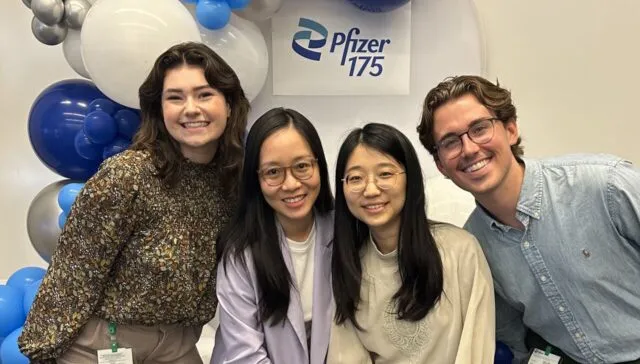Bridging the data equity gap

New software makes it easier to report personalized health-study data back to participants, helping bridge a data equity gap.
Health research depends on participant involvement, but participants are rarely given back their personal data due to logistical challenges or fear of providing confusing information. This paradigm is one of data inequity. Newly released software, developed by researchers at Boston University’s School of Public Health, aims to address data inequity by making it easier for researchers to personalize health study reports to deliver back to the participant.
Study participants are essential in health research
Study participants are an essential part of social and medical science research. When people enroll in clinical trials for new drugs, we can test the efficacy of a new therapy in the human body. When people agree to the measurement of air pollution and temperature in their homes, we can estimate the exposure and health impacts of indoor air pollution sources or energy-efficiency retrofits. When people answer national surveys about housing, energy use, and their personal health, we can study long-term trends of exposure and disease to track the impact of regional and national-scale policies. Indeed, much social, and medical science research would be impossible without participants.
Small incentives, but not knowledge transfer
Study participants often get small monetary honoraria. This is mainly to relieve:
- The burden of modifying daily routines to incorporate study methods
- Incentivize continued participation, or
- Reduce any discomfort of participation
However, individualized interpretations of a participant’s own study results—the most valuable compensation that can be offered—are not often shared. In most cases, reports given back to participants include study results aggregated across many participants, with some generalized explanations of standard values. This paradigm represents a data inequity from the accessibility standpoint, because study participants subsequently do not share in the benefits of or decision making resulting from research that has relied on their individual data (see p.15 of “Overcoming Barriers to Data Sharing in Public Health”).
Barriers in reporting individual results to participants
The reasons for this data inequity barrier in reporting is multi-faceted. Prior to contacting potential study participants, every method of a study must be approved by an ethical review board—at research universities, these are called Institutional Review Boards (IRB). Traditionally, IRBs have discouraged reporting results that lack a clear clinical significance or pathway for clinical remediation (see the Belmont Report, by the US Department of Health and Human Services). Furthermore, much reporting happens at the end of a study’s timeline, and practical constraints catch up with researchers—budgets are depleted, and staff time is limited. Caution and conservativism in reporting have long been the status quo. In the field of environmental health in the US, a problem of scale also emerges. Industry creates and releases tens of thousands of new chemicals per year, outpacing the ability of the US government to determine appropriate thresholds for exposure (given the current regulatory structure). This further complicates the ability of researchers to provide actionable guidance to study participants on what constitutes a “safe” level of exposure. (Environmental pollution by industry is handled differently country by country, but challenges in the US are described well here).
Using online tools to report individual results
In recent years, recognition of data inequity and the essential role that participants play in health research, and the desire of participants to receive their own data back (even if associated outcomes are uncertain), has prompted some teams to develop methods for easier reporting of health study results. At the vanguard of these efforts for biomonitoring data (e.g., chemicals in blood and urine) is the Digital Exposure Report-Back Interface (DERBI) tool by the Silent Spring Institute. This tool provides participants in health studies with a web portal to access their biomonitored data with a wealth of literature verified interpretations. DERBI also has the unique feature of allowing researchers to see how participants interact with their own data, allowing for the fine-tuning of results presentation and emphasis. DERBI has been used in a number of case studies, including the Center for Disease Control’s “Green Housing Study” and the “Detox Me Action Kit” biomonitoring study. However, biomonitoring is just one of many types of exposure/health reporting that health scientists do, and advanced software provides a technical barrier for both researchers implementing the software and participants using it.
Macro for Compilation of Report-backs (MCR) – a generalized software for reporting
The Community Engagement Core of the Boston University School of Public Health and Harvard T.H. Chan School of Public Health joint Center for Research on Environmental and Social Stressors in Housing Across the Life Course (CRESSH) recently faced a similar struggle. With limited resources and staff time, our study team wanted to create individualized reports of air pollution exposure for more than 150 participants in the Massachusetts cities of Dorchester and Chelsea, two environmental justice communities in the Greater Boston Area. However, our team had difficulty designing a report that contained the detailed information that our research/community board asked for without exhausting our resources.
From this tension, we created a new software tool that greatly enabled the ability of researchers to rapidly compile personalized reports—the Macro for Compilation of Report-backs (MCR). MCR is a macro-enabled Microsoft Excel workbook that enables users to compile detailed and individualized reports for study participants to help share and explain participant’s data. No technical expertise is required to use MCR other than familiarity with Microsoft Word and Excel. Researchers create report templates, import participant results, and run MCR to “fill in” the report template with results from each participant.
Researchers on CRESSH used MCR to create more detailed reports, including a greater frequency of individualized numerical, text, and graphical results. These reports were compiled in a fraction of the time of manual compilation and researchers reported feeling more creative in the design process and increased confidence in report-back quality control. We published a journal article on researcher feedback in using MCR, and made the MCR program freely available, along with demonstration templates and results files.
Future possibilities of personalized reporting
MCR and software like it can greatly extend the impact of health studies, as more flexible communication methods allow teams to more easily meet the specific graphicacy and literacy needs of various populations. Doing a better job translating the findings of health science research could have large implications for individual decision-making in a variety of personal domains (e.g., health decisions, spending, voting). The next phase of personalized reporting research follows from this line of thinking— how can we adapt our messaging to motivate behavior change around health? What presentation or explanation of exposures will inspire participants to use a different cleaning product, or remember to clean the filter of their portable air cleaner or A/C unit? Answering these questions opens the door to new research questions that address the oft-described knowledge gap with the general public and can empower research participants to make transformative changes in their daily lives.
Dr. Chad Milando is a Research Scientist in the Department of Environmental Health at Boston University School of Public Health. His research focuses on developing and using computational tools and analyses to investigate trends and sources of air pollution exposure, with a specific focus on vulnerable populations. He is currently building indoor airflow simulations and cumulative risk assessments for children with asthma in Boston, MA.




